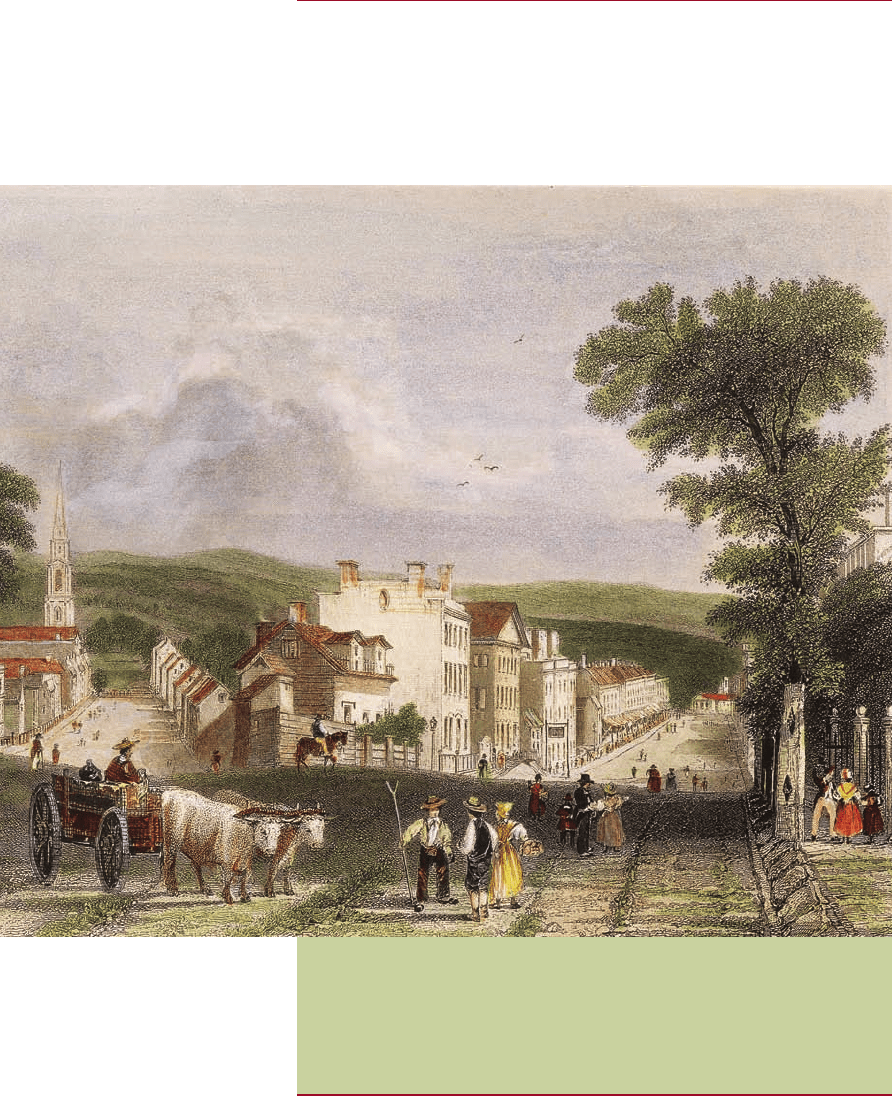McNeese T. Early National America 1790-1850 (Discovering U.S. History)
Подождите немного. Документ загружается.


Early National America
80
an age OF PraCTiCal invenTiOns
Almost no factories had existed
in America during the Colonial
Period, but the end of the eighteenth
century saw the beginnings of such
infant industries. One of the earliest
factories in America was constructed
by an English immigrant, named
Samuel Slater, who had built such
work places in Great Britain before
coming to the United States to do the
same. In 1790 Slater’s textile mill was
opened in Rhode Island and during
the next 20 years additional factory
mills were constructed.
The early nineteenth century
witnessed a trove of important
inventions, each of which made its
own unique contribution to American
life. Steam power was harnessed
and used to power mills, factories,
steamboats, and early railroads.
The fi rst practical, commercially
profi table steamboat was invented in
1807 by a New Yorker named Robert
Fulton. Steam power was fi rst used to
develop early railroads in England.
America’s fi rst railroad locomotive
was built by Peter Cooper in 1830.
Steam-powered travel provided faster
transportation on land and on interior
rivers and lakes than had ever been
previously imagined.
Jackson tried to stave off the economic avalanche, but
he only managed to make matters worse. In the summer of
1836 he issued his “Specie Circular,” an executive order that
required all government land agents to accept only hard cur-
rency—gold or silver—as payment for land sales. This sent
shockwaves across the West, where land speculators had
been selling millions of acres, taking paper money as pay-
ment. The “Specie Circular” nearly dried up the land mar-
ket. With little hard currency in circulation, people could
not buy land, sales plummeted, and the government lost one
of its most important sources of income—the sale of public
lands. It all fell apart quickly. Prices and interest rates rose.
Between 1834 and 1837 prices in America increased by 28
BOOK_4_Early_National.indd 80 24/6/09 14:57:02

81
The Age of Jackson
Farmers found their work eased by
such inventions as John Deere’s steel
plow (1837) and Cyrus McCormick’s
automatic reaping machine (1831),
which replaced workers who had
previously cut grain with hand-held
scythes.
In 1844 an American inventor,
Samuel F. B. Morse, developed a
working model of the fi rst magnetic
telegraph. This invention provided
instant communication over long
distances, something never previously
achieved in the history of humankind.
While the inventor of the cotton
gin, Eli Whitney, had also pioneered
the manufacturing system that relied
on interchangeable parts in gun
manufacture, it was Samuel Colt who
made the fi rst successful, repeating
revolver (1836) using interchangeable
parts.
Everything from the sewing
machine (1846) to the rotary printing
press (1847), suspension bridges
spanning major rivers (1847), an
effi cient steel-making process (1852),
the passenger elevator (1853), and
the vacuum evaporator for canning
food products with a long shelf life
(1846) came into reality during the
years prior to the Civil War. America
became more reliant on such
inventions for quicker transportation,
better communication, and greater
productivity.
percent! The money supply was infl ated. Businesses were
overextended. The Bank of the United States called in piles
of loans, including those to states that had borrowed to pay
for internal improvements, such as canals and railroads. The
Bank of the United States and other Eastern banks refused to
accept paper money for debt payments. State banks, having
dramatically overextended themselves, were driven out of
business. The Panic of 1837 loomed across the country.
An Economic Mess
Perhaps ironically, Jackson was not blamed for the economic
collapse, even though it was partially of his making. Many
factors, including bank collapses, did not kick in until the
BOOK_4_Early_National.indd 81 24/6/09 14:57:04

82
Early National America
A view of Utica, New York, in 1838. Starting around
1800, many farmers and their families moved to urban
areas to fi nd better lives. While cities developed
quickly, towns remained rural for decades.
spring of 1837, when Jackson was already out of offi ce and
a new president, former vice president Martin Van Buren,
was the chief executive. The depression was widespread. In
New York City alone, 50,000 people became unemployed.
BOOK_4_Early_National.indd 82 24/6/09 14:57:06

83
The Age of Jackson
Despite some temporary recovery in 1838, the panic contin-
ued through 1843.
Van Buren was unable to cope with the economic mess.
With no Bank of the United States by 1837, he proposed
a new regional treasury system in an effort to take federal
monies out of the unstable state banks where Jackson had
put them. But his Independent Treasury Act, which passed
Congress in 1840, only allowed the newly established trea-
sury branches to accept gold and silver coins (specie), not
paper money. These federal branch banks would not accept
checks drawn on state banks, which simply deprived such
banks of specie, making them even more unstable. It took
years before the American economic system was back on its
feet and thriving again. Jackson’s economic policies, includ-
ing his destruction of the Bank of the United States and his
limited view of money, had helped create a monster.
NEW AMERICAN POLITICS
Even though Jackson’s economic policies only pushed the
United States into a serious depression, he remained a popu-
lar president throughout his eight years in office, a man of
the people. His supporters—the “common man”—included
frontiersmen, artisans, day laborers, and yeoman farmers
and many of them felt about the Bank of the United States as
Jackson did. It seemed at times that, no matter what Jackson
did, he remained the great symbol for the nation’s middle
and underclasses. He was seen as a leader who stood up to
the powerful and wealthy.
Democrats and Whigs
Prior to Jackson’s presidency, the old Democratic-Republican
Party had split into the National Republicans and the Demo-
crats. It was the Democrat wing of the party that provided
Jackson’s political core. But this new party, the Democrats,
BOOK_4_Early_National.indd 83 24/6/09 14:57:06

84
Early National America
remained intact even after Jackson finished his presidency
and retired back to Tennessee, becoming the most viable and
long-lasting of the two parties. In fact from 1828 to 1860 the
Democrats dominated American politics, winning the presi-
dency in each election with only two exceptions—1840 and
1848.
As for the National Republicans, they did not even survive
the Jackson presidency. But, from the rubble of the aban-
doned National Republicans, another party was formed. It
was first little more than an anti-Jackson coalition, whose
members saw Jackson as too powerful, too forceful. Some
referred to Jackson as “King Andrew,” with some political
cartoons showing the president dressed in royal robes, a
crown on his head, his fist clenching a scepter. With this
“royal” image of Jackson, the new party soon took on the
label of the Whigs—the name of a group of Patriots of 1775
who were opposed to autocratic rule. The Whigs sometimes
proved a strong opposition force to Jackson. Party members
first polled significant numbers in congressional elections
in 1834, the midway point of Jackson’s second term. By
the 1840s, the Whigs were nearly equal in political pow-
er with the Democrats. In national elections, both parties
polled similar numbers of votes. The Whigs took a lesson
from Jackson’s political legacy as president. They attempted
to sell themselves as the party of the common voters, hop-
ing to draw some of Jackson’s supporters away from the
Democrats.
More People Get the Vote
Both the Democrats and the Whigs took significant steps
to change voting qualifications across the United States
and allow more people to vote. Those people would still be
white males, but the new qualifications included reducing or
eliminating the property qualification for voting. The result
BOOK_4_Early_National.indd 84 24/6/09 14:57:07

85
The Age of Jackson
of such changes meant that many more Americans were
able to cast ballots than ever before. In 1824 approximately
360,000 voted. But just four years later the number of vot-
ers increased to 1.1 million. That number continued to rise
until it reached 2.4 million voters in the 1840 election.
But the rise in the number of voters does not tell the
full story. The proportion of eligible voters who cast ballots
increased as well. In 1824 only around 27 percent of those
eligible to vote actually did so. But through the elections
from 1828 to 1836, the percentage of eligible voters who cast
ballots rose to approximately 55 percent. By 1840 the per-
centage of involved voters had risen to a whopping 80 per-
cent—four out of five eligible voters. All this means that the
two political parties were popular with their own constitu-
encies, were responsive to the political will of the people,
and that barriers limiting the percentage of white males who
cast their votes had been broken down. Unfortunately, how-
ever, women continued to be denied the privilege of voting.
There were differences between the two parties, to be cer-
tain. The Whigs supported a national bank, paper currency,
and the expansion of business corporations. The Democrats
did not generally endorse these issues. Whigs also favored
the advancement of social and humanitarian reforms in
America, such as the development of a public school sys-
tem, a temperance movement to limit alcohol consump-
tion, prison and asylum reforms, and the abolition of capital
punishment. Again, Democrats were typically lukewarm on
these issues.
While the American political system was rapidly chang-
ing to accommodate the “common man,” President Martin
Van Buren quickly proved to be less popular than Andrew
Jackson. He struggled through his term of office with a slid-
ing economy. He was elected in 1836 against three Whig
challengers—William Henry Harrison, Daniel Webster, and
BOOK_4_Early_National.indd 85 24/6/09 14:57:07

Early National America
86
Hugh Lawson White—each chosen to appeal to a given
region of the country. The Whigs had hoped to split the vote
as dramatically as had happened in 1824 and throw the elec-
tion into the House of Representatives, but the move failed,
with Van Buren winning nearly 51 percent of the vote to 49
percent for his three opponents combined.
THE ELECTION OF 1840
However, with the poor economy during the Van Buren
presidency, the Whigs felt confident in 1840 that they had a
sure shot at gaining the leadership of the executive branch.
Again they chose William Henry Harrison. Like Jackson,
he was an aging Indian fighter, a former Western governor
(of Indiana), and a well-known national figure. The party
selected John Tyler, a Virginia senator, as his running mate.
Tyler, a former Democrat, had left that party over Jackson’s
destruction of the Bank of the United States.
The 1840 election proved as rousing as any to date. There
were songs and slogans in support of each party’s candidate.
Whigs chanted at rallies and other public gatherings, “Van,
Van, Van; Oh! Van is a used-up man!” Tennessee Congress-
man Davy Crockett even claimed that Van Buren wore silk
stockings and a corset. Democrats formed political groups
called O.K. Clubs. Van Buren, from an old Dutch family, was
raised in the New York settlement of Old Kinderhook. In their
slogans, Van Buren was referred to as “O.K.” This became
the likely origin of the common term used today to indicate
that something is acceptable. Perhaps the best remembered
slogan was in support of Harrison, who in 1811 had led mili-
tary forces against the Shawnee in the battle of Tippecanoe.
The slogan—“Tippecanoe and Tyler, Too”—reminded the
voters of their candidate’s past as an Indian fighter.
Neither candidate actively campaigned in 1840, as it was
not the custom for candidates to do so in that era. But the
BOOK_4_Early_National.indd 86 24/6/09 14:57:07

87
The Age of Jackson
campaign was filled with political rallies and parades, bon-
fires and fish fries, all designed to appeal to the “common
man.” When Democrats accused Harrison of being little
more than a tooth-sucking rube who lived in a log cabin on
the frontier, where he drank hard cider, the Whigs turned it
into a positive, running their man as the “log cabin and hard
cider” candidate. In the end, this image appealed to voters,
who turned out in record numbers. With a voter turnout of
80 percent, Harrison was elected with 1.27 million votes,
to Van Buren’s 1.12 million votes. As president, Harrison
intended to support such Whig measures as a new national
bank and higher tariffs, but he did not live to do so. Within
a month of his inauguration in March 1841, the 68-year-old
Harrison died of pneumonia, making him the first president
to die in office.
BOOK_4_Early_National.indd 87 24/6/09 14:57:07

5
A New
American
Spirit
88
A
s Americans entered the nineteenth century, many did
so with enthusiasm and great anticipation concerning
the young republic’s future. In newspapers, sermons, and
speeches, the nation’s leaders called for the people of the
United States to take hold of the opportunities before them.
The spirit of the new century, of a new age, was, as noted by
historian Robert Remini: “Go ahead. Go ahead… Go ahead
is the order of the day, the real motto of the country.” Mas-
sachusetts Senator Daniel Webster, known for his oratory,
suggested that “Our age is full of excitement,” and he was,
perhaps, telling the truth more than he knew.
During the fi rst 50 years of the nineteenth century Ameri-
cans experienced the most rapid period of change in their
country’s history to date. There were new inventions, new
means of travel and communication, and new lands to be con-
quered in the West. Immigrants from Europe were streaming
to America by the thousands, seeking new opportunities.
BOOK_4_Early_National.indd 88 24/6/09 14:57:08

89
A New American Spirit
The American people were intent on building two worlds
for themselves. The fi rst was materialistic, founded on busi-
ness, trade, commerce, and the personal accumulation of
wealth. As the European visitor Alexis de Tocqueville wrote
in his book, Democracy in America: “No man in America is
contented to be poor or expects to continue so.” The second
world was more philosophical, even spiritual. Many excited
A view of West Point on the Hudson River with
Robert Fulton’s steamboat Clermont steaming
upstream from New York to Albany. Fulton pioneered
long-distance journeys along many of America’s
longest rivers.
BOOK_4_Early_National.indd 89 24/6/09 14:57:10
